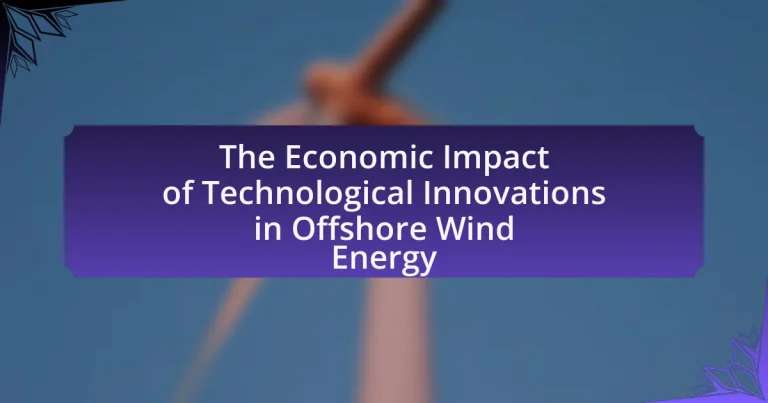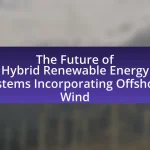The article examines the economic impact of technological innovations in offshore wind energy, highlighting how advancements in turbine design, floating wind farms, and energy storage systems have significantly reduced costs and increased efficiency. It details the decrease in the levelized cost of energy (LCOE) by 48% from 2010 to 2019, as reported by the International Renewable Energy Agency (IRENA), and discusses the potential for job creation, with projections of over 1.3 million jobs globally by 2030. The article also explores the role of government policies and regulations in fostering innovation, the long-term economic implications of these advancements, and the challenges faced in implementing new technologies within the sector.
What is the Economic Impact of Technological Innovations in Offshore Wind Energy?
Technological innovations in offshore wind energy significantly enhance economic outcomes by reducing costs and increasing efficiency. For instance, advancements in turbine design and installation techniques have led to a decrease in the levelized cost of energy (LCOE) from offshore wind projects, which fell by 48% between 2010 and 2019, according to the International Renewable Energy Agency (IRENA). Additionally, innovations such as floating wind farms expand the geographical range for wind energy production, potentially unlocking new markets and job opportunities. The deployment of these technologies can stimulate local economies through job creation in manufacturing, installation, and maintenance sectors, further contributing to economic growth.
How do technological innovations influence the offshore wind energy sector?
Technological innovations significantly enhance the offshore wind energy sector by improving efficiency, reducing costs, and increasing energy output. For instance, advancements in turbine design, such as larger rotor diameters and higher capacity factors, allow for greater energy capture from wind resources. According to the International Renewable Energy Agency (IRENA), the levelized cost of electricity from offshore wind has decreased by 48% between 2010 and 2019, primarily due to these innovations. Additionally, innovations in floating wind technology enable deployment in deeper waters, expanding the potential for offshore wind farms. These developments not only contribute to the economic viability of offshore wind projects but also support global renewable energy targets by increasing the share of clean energy in the overall energy mix.
What are the key technological advancements in offshore wind energy?
Key technological advancements in offshore wind energy include larger turbine sizes, floating wind farms, advanced materials, and improved energy storage systems. Larger turbines, such as those exceeding 10 MW, increase energy capture and efficiency, significantly reducing the cost per megawatt-hour. Floating wind farms enable deployment in deeper waters, expanding the potential for wind energy generation beyond traditional fixed-bottom installations. Advanced materials, like lighter and stronger composites, enhance turbine durability and performance. Additionally, improved energy storage systems, such as lithium-ion batteries and pumped hydro storage, facilitate better integration of offshore wind energy into the grid, ensuring a stable energy supply. These advancements collectively contribute to the economic viability and growth of the offshore wind sector.
How do these advancements improve efficiency and output?
Advancements in offshore wind energy technology improve efficiency and output by enhancing turbine design, increasing energy capture, and optimizing maintenance processes. For instance, the development of larger and more efficient turbines allows for greater energy generation per unit, significantly boosting output. According to the Global Wind Energy Council, the average capacity of offshore wind turbines has increased from 3.6 MW in 2015 to over 8 MW in 2021, leading to higher energy production rates. Additionally, innovations in predictive maintenance technologies reduce downtime by enabling timely repairs, which further enhances operational efficiency. These advancements collectively contribute to a more productive and economically viable offshore wind energy sector.
What economic benefits arise from these technological innovations?
Technological innovations in offshore wind energy lead to significant economic benefits, including job creation, reduced energy costs, and increased energy independence. For instance, the U.S. offshore wind sector is projected to create over 77,000 jobs by 2030, according to the U.S. Department of Energy. Additionally, advancements in turbine efficiency and installation techniques have resulted in a decrease in the levelized cost of energy (LCOE) for offshore wind, making it more competitive with fossil fuels. Furthermore, these innovations contribute to energy independence by diversifying the energy supply and reducing reliance on imported fuels, which enhances national security and stabilizes energy prices.
How do innovations reduce costs in offshore wind energy production?
Innovations reduce costs in offshore wind energy production by enhancing efficiency and lowering operational expenses. For instance, advancements in turbine design, such as larger rotor diameters and higher capacity factors, allow for increased energy generation while reducing the cost per megawatt-hour. According to the International Renewable Energy Agency, the levelized cost of electricity from offshore wind has decreased by 48% between 2010 and 2019, largely due to technological improvements. Additionally, innovations in installation techniques, such as the use of floating platforms and automated vessels, minimize labor costs and construction time, further driving down overall expenses.
What is the impact on job creation within the offshore wind sector?
The offshore wind sector significantly impacts job creation, with estimates indicating that it could generate over 1.3 million jobs globally by 2030. This growth is driven by advancements in technology, which enhance efficiency and reduce costs, leading to increased investment and expansion of offshore wind projects. For instance, the International Renewable Energy Agency reported that the sector employed approximately 1.2 million people in 2020, with projections suggesting a rise as countries transition to renewable energy sources. The creation of jobs spans various roles, including manufacturing, installation, maintenance, and research and development, contributing to local economies and fostering a skilled workforce in the renewable energy sector.
How do technological innovations affect investment in offshore wind energy?
Technological innovations significantly enhance investment in offshore wind energy by improving efficiency, reducing costs, and increasing energy output. For instance, advancements in turbine design, such as larger rotor diameters and higher capacity factors, allow for greater energy generation from the same wind resources, making projects more economically viable. According to the International Renewable Energy Agency (IRENA), the cost of offshore wind energy has decreased by 48% between 2010 and 2019, largely due to technological improvements. Additionally, innovations in floating wind turbine technology enable deployment in deeper waters, expanding the potential sites for wind farms and attracting more investment. These factors collectively create a more favorable investment climate, as they promise higher returns and lower risks for investors in the offshore wind sector.
What role do innovations play in attracting investors?
Innovations play a crucial role in attracting investors by demonstrating the potential for increased efficiency, cost reduction, and competitive advantage in the offshore wind energy sector. For instance, advancements in turbine technology and energy storage solutions can significantly enhance energy output and reliability, making projects more appealing to investors. According to a report by the International Renewable Energy Agency, innovations in offshore wind technology have led to a 50% reduction in costs over the past decade, which directly correlates with increased investment in the sector. This trend illustrates that investors are more likely to commit capital to projects that leverage cutting-edge technologies, as these innovations promise higher returns and lower risks.
How do advancements in technology enhance project viability?
Advancements in technology enhance project viability by improving efficiency, reducing costs, and increasing the reliability of offshore wind energy projects. For instance, innovations such as larger and more efficient turbines can generate more energy per unit, leading to lower costs per megawatt-hour. According to the International Renewable Energy Agency, the cost of offshore wind energy has decreased by 48% between 2010 and 2019 due to technological improvements. Additionally, advancements in predictive maintenance and monitoring technologies reduce downtime and operational risks, further solidifying the economic feasibility of these projects.
What are the risks associated with investing in outdated technologies?
Investing in outdated technologies poses significant risks, including reduced competitiveness, increased maintenance costs, and potential obsolescence. Companies relying on outdated technologies may struggle to keep pace with industry advancements, leading to a loss of market share. For instance, a study by McKinsey & Company highlights that businesses using legacy systems can incur up to 30% higher operational costs compared to those adopting modern solutions. Additionally, outdated technologies may lack compatibility with newer systems, resulting in inefficiencies and increased downtime. This can ultimately hinder innovation and limit growth opportunities in rapidly evolving sectors like offshore wind energy.
How do government policies influence the economic impact of these innovations?
Government policies significantly influence the economic impact of technological innovations in offshore wind energy by providing regulatory frameworks, financial incentives, and support for research and development. For instance, policies such as feed-in tariffs and tax credits can lower the cost of investment for offshore wind projects, thereby accelerating their deployment and enhancing economic viability. According to the International Renewable Energy Agency, countries with supportive policies have seen a 20-30% reduction in the cost of offshore wind energy, demonstrating the direct correlation between government action and economic outcomes in this sector.
What incentives exist for adopting new technologies in offshore wind energy?
Incentives for adopting new technologies in offshore wind energy include government subsidies, tax credits, and research grants. These financial supports encourage investment in innovative solutions that enhance efficiency and reduce costs. For instance, the U.S. federal government offers the Investment Tax Credit (ITC), which allows developers to deduct a significant percentage of their investment in renewable energy projects from their federal taxes. Additionally, the European Union has implemented various funding programs, such as Horizon Europe, which allocates billions for research and innovation in renewable energy technologies. These incentives not only stimulate technological advancements but also contribute to the overall growth of the offshore wind sector, promoting sustainability and energy independence.
How do regulations shape the development of technological innovations?
Regulations significantly influence the development of technological innovations by establishing standards and frameworks that guide research, investment, and implementation. For instance, in the offshore wind energy sector, regulations such as the Renewable Energy Directive in the European Union set ambitious targets for renewable energy production, which incentivizes innovation in turbine design and energy efficiency. Additionally, safety and environmental regulations compel companies to invest in advanced technologies that minimize ecological impacts, thereby fostering innovation. Historical data shows that countries with robust regulatory frameworks, like Denmark, have seen accelerated growth in offshore wind technology, leading to a 40% reduction in costs over the past decade. This correlation between regulation and innovation underscores the critical role that policy plays in shaping technological advancements.
What are the long-term economic implications of technological innovations in offshore wind energy?
Technological innovations in offshore wind energy lead to significant long-term economic implications, including reduced energy costs, job creation, and enhanced energy security. The advancements in turbine efficiency and installation techniques have decreased the levelized cost of energy (LCOE) for offshore wind, making it competitive with fossil fuels; for instance, the LCOE for offshore wind has dropped by approximately 70% since 2010, according to the International Renewable Energy Agency (IRENA).
Additionally, the growth of the offshore wind sector is projected to create millions of jobs globally, with the Global Wind Energy Council estimating that the industry could employ over 1.3 million people by 2030. This job creation spans manufacturing, installation, and maintenance, contributing to local economies and fostering regional development.
Moreover, technological innovations enhance energy security by diversifying energy sources and reducing dependence on imported fuels. Countries investing in offshore wind can stabilize their energy prices and mitigate the risks associated with volatile fossil fuel markets. Overall, these economic implications underscore the transformative potential of technological advancements in offshore wind energy.
How do these innovations contribute to energy independence?
Innovations in offshore wind energy significantly contribute to energy independence by enhancing the efficiency and scalability of renewable energy production. These advancements, such as improved turbine designs and advanced materials, enable higher energy output and reduced costs, making offshore wind a more viable alternative to fossil fuels. For instance, the deployment of larger turbines has increased energy capture, with some models generating over 10 megawatts per unit, which can power thousands of homes. This shift towards renewable sources reduces reliance on imported fuels, thereby bolstering national energy security and promoting self-sufficiency in energy production.
What is the potential for offshore wind energy in reducing reliance on fossil fuels?
Offshore wind energy has significant potential to reduce reliance on fossil fuels by providing a clean, renewable source of electricity. According to the International Energy Agency, offshore wind capacity could reach 234 gigawatts by 2030, which could displace a substantial amount of fossil fuel generation. This transition is crucial as the energy sector is responsible for approximately 73% of global greenhouse gas emissions, and increasing offshore wind capacity can help mitigate climate change impacts while promoting energy security.
How do technological advancements affect energy prices in the long run?
Technological advancements generally lead to a decrease in energy prices in the long run. Innovations in offshore wind energy, such as improved turbine efficiency and reduced installation costs, have significantly lowered the levelized cost of energy (LCOE). For instance, according to the International Renewable Energy Agency (IRENA), the global average LCOE for offshore wind fell by 29% between 2019 and 2020, demonstrating the impact of technological improvements. Additionally, advancements in energy storage and grid integration enhance the reliability and efficiency of renewable energy sources, further contributing to lower energy prices over time.
What challenges do technological innovations face in offshore wind energy?
Technological innovations in offshore wind energy face challenges such as high capital costs, complex regulatory environments, and technological integration issues. High capital costs are a significant barrier, with offshore wind projects requiring substantial initial investments, often exceeding billions of dollars. The complexity of regulatory environments can delay project approvals and increase costs, as developers must navigate various local, national, and international regulations. Additionally, integrating new technologies with existing infrastructure poses technical challenges, as compatibility and reliability must be ensured to optimize performance and reduce maintenance costs. These factors collectively hinder the rapid deployment and scalability of offshore wind energy technologies.
What are the barriers to implementing new technologies?
The barriers to implementing new technologies in offshore wind energy include high initial costs, regulatory challenges, and a lack of skilled workforce. High initial costs can deter investment, as the capital required for infrastructure and technology development is substantial. Regulatory challenges arise from complex permitting processes and compliance with environmental standards, which can delay project timelines. Additionally, the lack of a skilled workforce limits the ability to effectively deploy and maintain new technologies, hindering overall progress in the sector. These factors collectively impede the adoption of innovative solutions necessary for advancing offshore wind energy.
How can these challenges be overcome to maximize economic benefits?
To overcome challenges in offshore wind energy and maximize economic benefits, stakeholders must invest in advanced technologies and infrastructure. Implementing predictive maintenance systems can reduce downtime and operational costs, as evidenced by a study from the National Renewable Energy Laboratory, which found that predictive maintenance can lower maintenance costs by up to 30%. Additionally, enhancing supply chain logistics through digital platforms can streamline operations, reducing delays and increasing efficiency. Collaboration among industry players, government, and research institutions can foster innovation and share best practices, further driving down costs and improving project viability.
What best practices can be adopted to enhance the economic impact of technological innovations in offshore wind energy?
To enhance the economic impact of technological innovations in offshore wind energy, best practices include fostering public-private partnerships, investing in research and development, and implementing supportive regulatory frameworks. Public-private partnerships can leverage resources and expertise, as seen in the collaboration between governments and companies like Ørsted, which has led to significant advancements in offshore wind technology. Investing in research and development is crucial; for instance, the U.S. Department of Energy’s Offshore Wind Initiative aims to reduce costs and improve efficiency, targeting a 50% reduction in the cost of offshore wind energy by 2030. Additionally, supportive regulatory frameworks, such as streamlined permitting processes and incentives for renewable energy projects, can accelerate deployment and attract investment, as demonstrated by the success of the UK’s Contracts for Difference scheme, which has driven down costs and increased capacity in the offshore wind sector.




